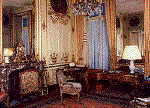General Bonaparte married 'Josephine' on 9 March, 1796, in Paris at the Mairie of the 2nd arrondissement, in other words the Hôtel Mondragon, the present-day head office of the bank Paribas. And the salon where the ceremony took place has been preserved just as it was on that historic day.
The Hôtel de Mondragon was built as a result of the urban planning of the neighbourhood around the Place Vendôme, started at the beginning of the 18th century. In the period 1715 and 1725, the general treasurer of the Royal Bank, Pierre Etienne de Boynes, had a mansion built on a parcel of land between the recently-built rue d'Antin and rue Louis Legrand – the architect of the house is not known. The architecture is sober and simple, and the salons (which give onto the façade over rue d'Antin) were decorated in 1754. At that date, the mansion was sold to Duval de l'Epinoy, secretary to the king, and it was his descendants, the Gallet de Mondragon, who left their name to the building.
Confiscated during the Revolution as 'national property', the house was put up for tender, eventually being rented out to the Mairie of the IInd arrondissement. On 9 March, 1796, the marriage of the 'first couple to be' took place. Josephine arrived at 8 pm, to find her witnesses Barras and Tallien, and one of Napoleon's witnesses, Calmelet, waiting for her. Bonaparte's second witness, Le Marois, came with Bonaparte himself two hours later. The delay was doubtless because of the illegal substitution of the state marriage official, Charles Leclerq with a commissar of Directory, Collin-Lacombe – indeed Collin-Lacombe's name does not appear on the marriage certificate. What is more, the document is riddled with mistakes. Bonaparte's birth is recorded as 5 February, 1768 instead of 15 August, 1769, something which makes him a Genovese citizen as opposed to one from Corsica. He is described as 'chef de l'armée de l'Intérieur' (Head of the National Army), when in fact, since 2 March he had been 'chef de l'armée italienne' (Head of the Italian army). His address is given as rue d'Antin despite his living at that time in rue Neuve des Capucins! As for Josephine, she is made four years younger so as to make the marriage certificate correspond to the marriage contract signed the day before. One final irregularity: captain Le Marois was not legally old enough to be witness to a marriage ceremony. Despite all this, the marriage was sealed and the couple spent their wedding night in Josephine's mansion in rue Chantereine.
The house remained a Mairie until 1834 and the salon was the setting for the marriage ceremonies (amongst many others) of Marmont (1798) and the parents of George Sand (1804). Reclaimed by the Mondragon family under the July Monarchy, the mansion was handed over to the Banque de Paris in 1869. In 1872 a new bank was created (a merger of the Banque de Paris and the Banque de crédit et de dépôt des Pays-bas), the present-day Paribas, and the Hôtel de Mondragon became their head offices, spreading also to the Hôtel Gabriel in 1875.
The salon where Josephine and Bonaparte were married – today the office of the manager of Paribas – and the following salon which in those days was a waiting room, have still their original 'rocaille' decoration. The white painted woodwork highlighted with gilt and the elegant stucco work (symbolising the elements) alternate with panels painted by Noël Coypel, and Sébastien II Le Clerc, one a personification of music and the other a figure representing the art of drawing. A magnificent bust of Josephine by Chinard stands on the mantelpiece. A copy of the certificate (made in 1829 – pp. 1, 2, 3) is on show in the salon itself, the original having been destroyed in a fire during the Commune period. On the exterior on rue d'Antin, two commemorative plaques (one of which placed there by the Napoleon Foundation for the bi-centenary in 1996) mark the spot of this famous marriage.
Hôtel de Mondragon


